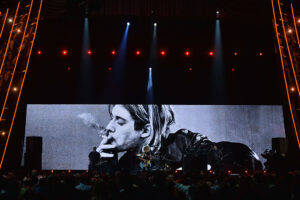Here We Are Now, Adjudicate Us! Notes From Nirvana’s Copyright Squabble
Nirvana, the standard-bearer of all things grungy, is back -- in court.

(Photo by Larry Busacca/Getty Images)
Grunge is back. This is apparent from the massive explosion in the wearing of gigantic, distressed pants with artfully ragged hems. And the return is not limited to fashion.
Nirvana, the standard-bearer of all things grungy, the totemic band that brought plangent, mumbled lyrics and sludgy guitars to the mainstream, who deplored optimism while wearing floral cardigans, is back — in court.
Lead singer Kurt Cobain has passed, but the band’s remaining members are embroiled in a complex copyright battle over the band’s iconic, blissed-out yellow logo. You have probably seen this logo peeping out at you from its place on a black T-shirt beneath an unbuttoned flannel. It is a take on the classic “smiley face,” with an “x” for each eye, a wobbly grin that implies intoxication, and a rudely protruding tongue. It usually appears below the band’s name in bold all-caps and is oft referred to as the “Smiley.”
That logo is at the crux of the proceedings in Nirvana, LLC v. Marc Jacobs International, LLC; et al. Specifically, who owns the logo and who can sell merchandise bearing same. The issue reached the courts when high-style designer Marc Jacobs started producing and selling shirts that included a derivative of the Nirvana logo. Jacobs kept the same striking black-and-yellow colorway, the wobbly mouth, the protruding tongue, and the same overall look and feel of the Nirvana logo, but replaced “NIRVANA” with “HEAVEN” and the x-eyes with an m-eye and a j-eye, presumably to reference the designer’s initials. Nirvana sued, as might be expected, to preclude this corporate exploitation of their iconic logo. And that’s when things got interesting.
Ownership of the work at issue is a fundamental element of a copyright claim. Nirvana initially laid claim to the Smiley’s copyright by virtue of Cobain’s alleged creation of at least some of the logo artwork back in the 1990s. Given his passing, the evidence of this creation is spotty. There were apparently no witnesses to his creation of the work, or sketches or drawing evidencing his creation, and he never executed any documents noting his creation or transferring any rights in the work. But the artwork is in his style and he created virtually all of the artwork for the band at the time of its creation. And, it seems, no one had ever really challenged his creation.
Until now. Learning of the case, Robert Fisher sought to intervene. A graphic designer by trade, he claimed that he was the one that created the Smiley, doing so as a favor for Nirvana, with the understanding they would use it on merchandise. Fisher claims to possess all of the details of the logo’s creation as well as the original Xerox blowup of the Smiley. He also for years has included the Smiley in his personal design portfolio, which he circulates to promote his services. Fisher disputes that Cobain created most of Nirvana’s art, pointing to, among other things, band album covers created by third parties.
Against this backdrop, the district court was asked to adjudicate the ownership question. A couple of key facts drove the decision, including that Fisher worked for Nirvana’s record label, Geffen, at the time he allegedly created Smiley, and knew the design was intended for merchandise. As a result, under 17 U.S.C § 201(b), Geffen would have owned the Smiley’s copyright as a work-for-hire. Geffen, now owned by UMG, disclaimed any ownership in the Smiley but nevertheless, during the lawsuit’s pendency, executed a transfer of the Smiley’s copyright to Nirvana.
The court homed in on the work-for-hire issue, which allowed it to sidestep the competing versions of the Smiley’s creation and conclude that even if Fisher created the logo it would have been as a work-for-hire for his employer, Geffen, and was subsequently transferred to Nirvana. While this analysis serves the equities and makes sense given the decades of Nirvana’s use without complaint of the logo, it does have a few fleas.
For one, it contravenes Geffen/UMG’s assertions that Cobain drew the logo and that it never had copyrights in the logo, as a work-for-hire or otherwise. If UMG/Geffen owned the copyrights since the 1990s, then Nirvana was exploiting the logo on a dubious legal footing until the middle of this lawsuit, when the transfer was executed. Per 17 USC 204, ownership of a copyright cannot be transferred without the execution of a written contract. Given that no contract existed until recently, Nirvana’s ownership of the logo could be of that same recent vintage.
The court also grapples with the issue of how the statute of limitations applies to ownership claims. There exists, unfortunately, for ownership claims a court-created carveout from the normal infringement statute.The statute on ownership disputes runs three years after anyone expressly repudiates another author’s ownership by, for example stating “you’re not the owner, I am” or exploiting the artwork in a manner inconsistent with the artist’s ownership. The court focuses on the fact that Fisher did not repudiate Geffen or UMG’s ownership in the past. But, the query could have been whether Nirvana repudiated Geffen or UMG’s ownership. And it apparently did, by making and selling merchandise bearing the logo for decades. If this constituted repudiation, then Geffen/UMG would be precluded from challenging Nirvana’s ownership and the result might be different here. But, there are material issues with this doctrine arising from the fact that nobody really knows what “express repudiation” means, and there is nothing in the doctrine that stops any rando off the street from sending a letter to Paul McCartney, claiming ownership of a famous work, like the Beatles’ “Abbey Road,” and then, assuming no response, claiming ownership once three years pass without Sir Paul filing a lawsuit.
Copyright registration invalidity also plays a part in this case, though the court seems to misapply the presumption of validity that attaches to a registration. There are also trademark and trade dress issues if that’s your bag.
At the end of the 34-page ruling, the court tees up the ultimate question of infringement for trial. As you might imagine, Fisher has already sought the right to file an interlocutory appeal, but the court indicated in March that the request would likely be denied. So, barring a settlement, Nirvana will find themselves not on stage but on the stand this summer or fall.

How The New Lexis+ AI App Empowers Lawyers On The Go
 Scott Alan Burroughs, Esq. practices with Doniger / Burroughs, an art law firm based in Venice, California. He represents artists and content creators of all stripes and writes and speaks regularly on copyright issues. He can be reached at [email protected], and you can follow his law firm on Instagram: @veniceartlaw.
Scott Alan Burroughs, Esq. practices with Doniger / Burroughs, an art law firm based in Venice, California. He represents artists and content creators of all stripes and writes and speaks regularly on copyright issues. He can be reached at [email protected], and you can follow his law firm on Instagram: @veniceartlaw.
Sponsored

Law Firm Business Development Is More Than Relationship Building

AI Presents Both Opportunities And Risks For Lawyers. Are You Prepared?

Curbing Client And Talent Loss With Productivity Tech

How The New Lexis+ AI App Empowers Lawyers On The Go

Happy Lawyers, Better Results The Key To Thriving In Tough Times








